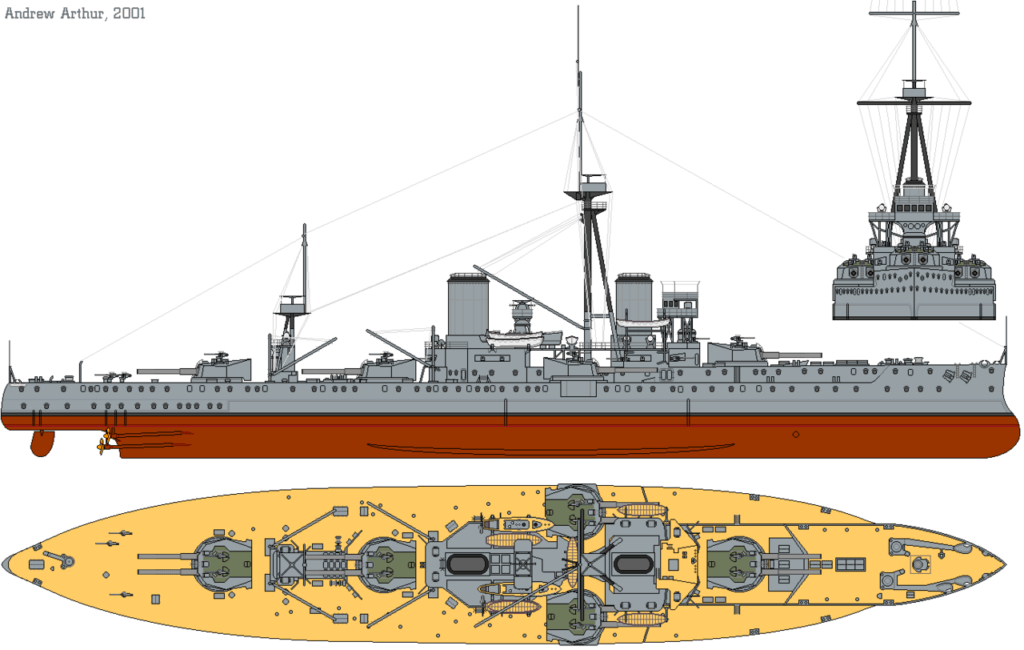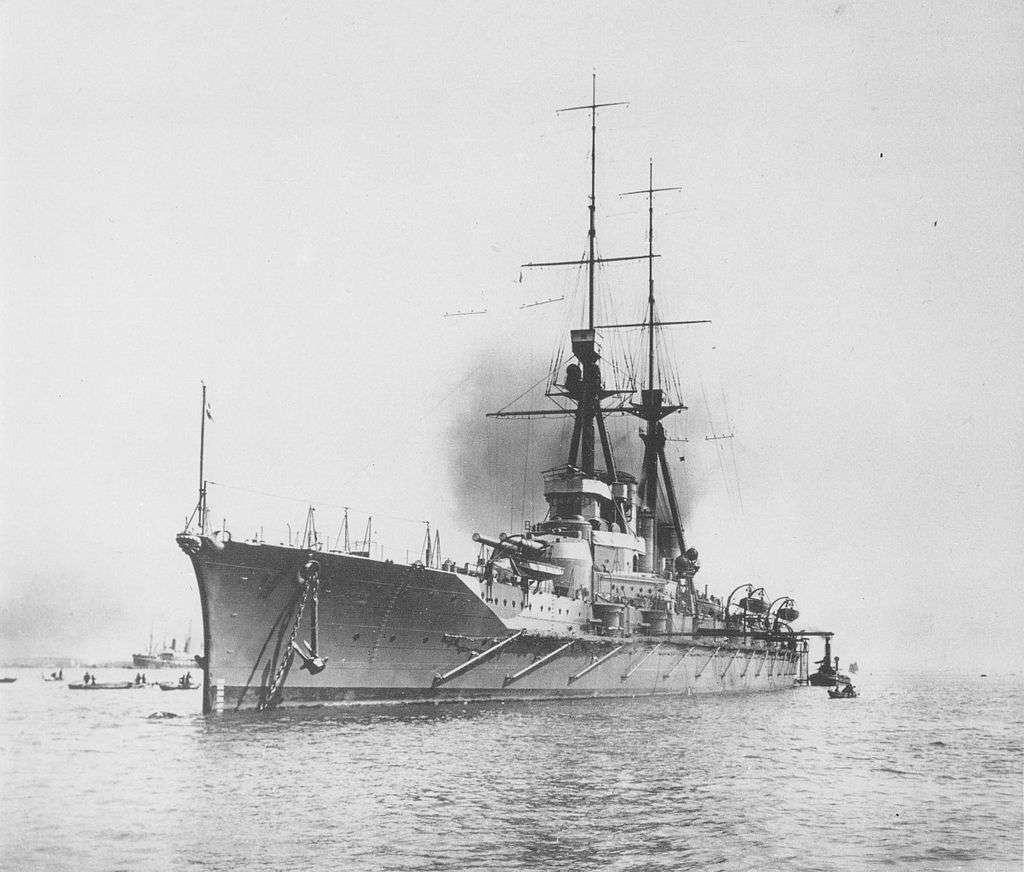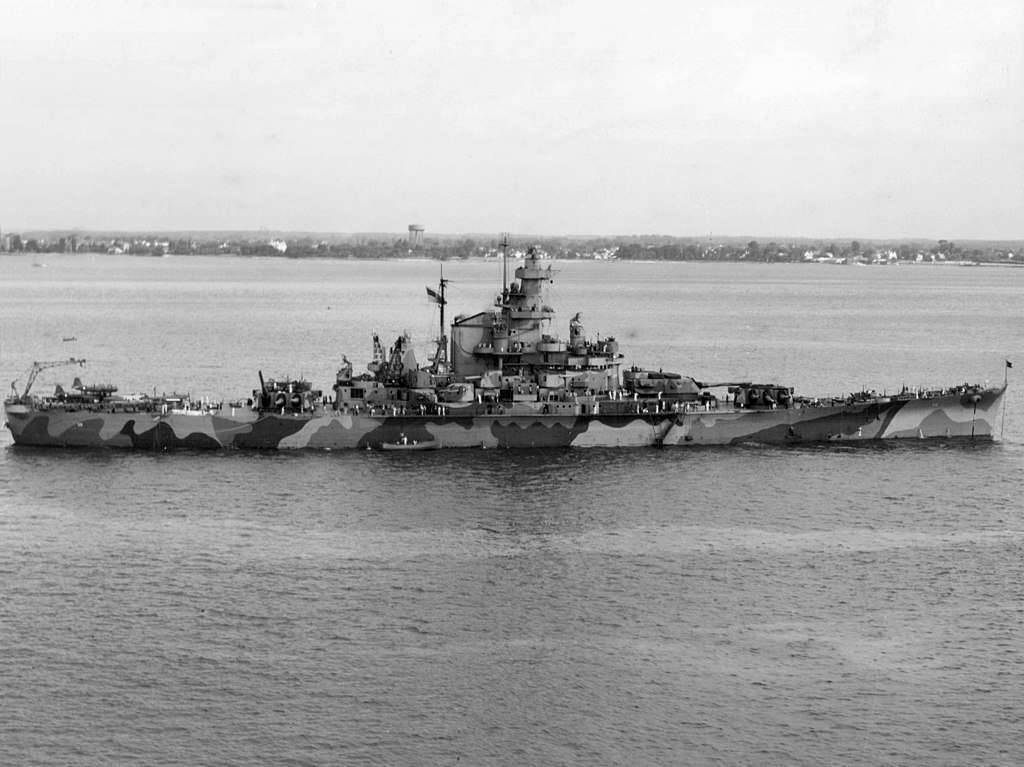Dreadnought and battleship are two terms often used interchangeably, but they have distinct meanings in naval history.

Here we aim to explore the difference between dreadnoughts and battleships, focusing on their historical context, armaments, years in service, and the countries that possessed these formidable vessels.
By examining these aspects, we can gain a deeper understanding of the evolution of naval warfare during the early 20th century.
Historical Context
To understand the difference between dreadnoughts and battleships, we must first delve into their historical context.
The term “dreadnought” originated from HMS Dreadnought, a revolutionary British battleship commissioned in 1906.
 HMS Dreadnought. The ship that gave others their name. But it’s not a battleship!
HMS Dreadnought. The ship that gave others their name. But it’s not a battleship!
It featured a new design concept that prioritised large-calibre guns, uniform main battery placement, and an “all-big-gun” configuration. The advent of HMS Dreadnought sparked an arms race among naval powers, leading to the development of similar vessels.
Dreadnoughts
Design and Armaments
Dreadnoughts, characterized by their technological advancements and innovative design, were a significant departure from previous battleships. They featured an all-big-gun main battery, typically comprising guns of a single calibre.
This design allowed for increased firepower and simplified ammunition logistics. The main guns of dreadnoughts were usually around 12 to 16 inches in calibre, providing superior range and striking power.
Years in Service and Nations with Dreadnoughts
Dreadnoughts saw active service from the early 20th century until the mid-20th century. The United Kingdom, as the birthplace of the dreadnought, led the way in their construction and deployment.
 A technical view of HMS Dreadnought. In its day it was modern and years ahead of the rest.
A technical view of HMS Dreadnought. In its day it was modern and years ahead of the rest.
The Royal Navy’s HMS Dreadnought, commissioned in 1906, was the first of its kind. It was followed by numerous British dreadnoughts, including the Queen Elizabeth-class and King George V-class battleships.
Other nations, such as the United States with its Nevada-class and North Carolina-class battleships, Germany with the Bayern-class, and Japan with the Nagato-class, also developed their own dreadnought fleets to compete for naval supremacy.
Battleships
Design and Armaments
Battleships, while sharing similarities with dreadnoughts, represent a broader category of warships that encompass various design iterations.
Battleships typically had a mix of gun calibres in their main battery and featured a combination of large and medium-calibre guns.
This allowed for versatility in engaging different types of targets. Battleships’ main guns ranged from 12 to 18 inches in calibre, depending on the specific class and design.
 The Kriegsmarine Scharnhorst as she was in 1943. Not a dreadnought!
The Kriegsmarine Scharnhorst as she was in 1943. Not a dreadnought!
Years in Service and Nations with Battleships
Battleships had a longer service life compared to dreadnoughts. They were prevalent during both World Wars and served as instrumental naval assets.
Various nations, including the United States, United Kingdom, Germany, Japan, and Italy, possessed battleships and deployed them in significant naval conflicts.
The United States’ Iowa-class battleships, the United Kingdom’s King George V-class, and Germany’s Bismarck-class battleships were among the notable examples.
The Main Difference
The main difference between dreadnoughts and battleships lies in their design philosophy.
While dreadnoughts represent a specific design concept characterised by all-big-gun configurations, battleships encompass a broader range of vessels with different armament configurations.
 The Japanese battleship Haruna in 2015. Its sleek design was different for a WW1 warship.
The Japanese battleship Haruna in 2015. Its sleek design was different for a WW1 warship.
Dreadnoughts prioritised uniformity in gun calibre, allowing for concentrated firepower and overwhelming striking power.
This concept of concentrated firepower was a revolutionary departure from previous battleship designs and aimed to achieve decisive naval superiority.
On the other hand, battleships encompassed a wider spectrum of designs, including those with mixed gun calibres.
Battleship designs evolved to incorporate a combination of large-calibre guns for long-range engagements and medium-calibre guns for anti-surface and anti-aircraft defence. Confused yet?
This versatility allowed battleships to engage a variety of targets effectively and adapt to different tactical situations.
Which is bigger, battleship or dreadnought?
At 526 ft long, the dreadnought was the biggest battleship of its time. Additionally, the dreadnought had large guns and was fast.
It could travel at 21 knots, which was a record time back then.
Despite all of this, the current record for the largest battleship is held by Japanese Yamato.
There’s More!
The distinction between dreadnoughts and battleships became less clear as naval technology progressed.
Later battleships incorporated elements of the dreadnought design, such as larger main battery guns, while also including secondary batteries and improved armour protection.
The term “dreadnought” eventually became synonymous with battleships of the early 20th century due to the revolutionary impact of HMS Dreadnought.
 The Battleship USS Indiana in 1942. Built for speed AND firepower.
The Battleship USS Indiana in 1942. Built for speed AND firepower.
Despite the technological advancements, the accuracy of the guns on dreadnoughts and battleships was not always perfect.
Factors such as gunnery training, target visibility, range estimation, and sea conditions could affect the accuracy of the guns.
However, these warships employed sophisticated fire control systems, including rangefinders and fire control computers, to improve accuracy.
Additionally, during combat, the ships would adjust their firing solutions based on feedback from initial salvos to increase their chances of hitting the target.
While dreadnoughts and battleships were formidable war machines, they were not without their flaws and vulnerabilities.
In the case of battleships, advancements in naval aviation and the emergence of aircraft carriers in the mid-20th century posed a significant threat.
The attack on Pearl Harbor in 1941, where several battleships were severely damaged or sunk by Japanese carrier-based aircraft, marked a turning point in naval warfare and highlighted the vulnerability of battleships to aerial attacks.
Verdict
The development of dreadnoughts revolutionised naval warfare, emphasising the importance of concentrated firepower and technological superiority.
Battleships, with their versatility and varied armament configurations, served as dominant naval platforms during both World Wars.
 HMS Resolution and HMS Formidable. One is a battleship, the other is neither a battleship nor a dreadnought. Confusing right?
HMS Resolution and HMS Formidable. One is a battleship, the other is neither a battleship nor a dreadnought. Confusing right?
While the accuracy of the guns on these warships was subject to various factors, they were formidable vessels that projected power and influence on the seas.
However, the emergence of aircraft carriers ultimately shifted the balance of naval power, rendering battleships less relevant in modern warfare.
The legacy of dreadnoughts and battleships continues to shape our understanding of naval history, highlighting the technological advancements, strategic considerations, and evolving tactics that have influenced the course of warfare at sea.
Their immense size, powerful armaments, and historical significance ensure their enduring place in the annals of naval warfare.





